Last updated: June 26, 2023
Article
Theodore Roosevelt Inaugural Site: Birthplace of the Modern Presidency (Teaching with Historic Places)
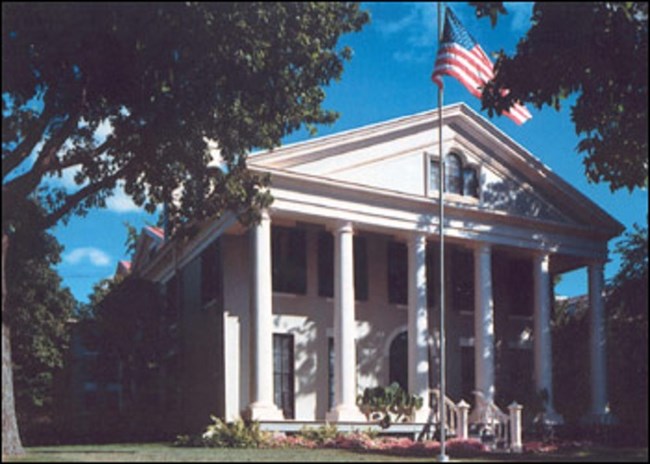
(Photo by K. C. Kratt, Theodore Roosevelt Inaugural National Historic Site)
This lesson is part of the National Park Service’s Teaching with Historic Places (TwHP) program.
While vacationing in the Adirondack Mountains of New York, Vice President Theodore Roosevelt learned the terrible news that President William McKinley was not expected to survive bullet wounds incurred days earlier during an assassination attempt in Buffalo, New York. By the time Roosevelt had completed the exhausting 15-hour journey to Buffalo, President McKinley had indeed succumbed to his injuries. Deeply saddened over McKinley's tragic death, yet knowing that the country must not be long without a leader, Roosevelt arrived at the home of his friend Ansley Wilcox. Here, in the library of this stately Greek Revival house, Roosevelt became the 26th President of the United States.
In his haste to reach Buffalo, Roosevelt had not taken time to gather any formal attire. Just prior to the inauguration ceremony, he borrowed a long frock coat, trousers, waistcoat, four-in-hand tie, and patent leather shoes. Tension and sadness filled the room as Roosevelt raised his right hand and recited the oath taken by every U.S. President. Though shrouded in shock and sadness at the time, Roosevelt's 1901 inauguration marked a turning point in the role of the presidency, launching a dramatic change in national policy and propelling the United States into the realm of world affairs. The house where the inauguration took place has been restored and is open to the public as Theodore Roosevelt Inaugural National Historic Site.
About This Lesson
This lesson is based on the National Register of Historic Places registration file for the "Theodore Roosevelt Inaugural Site" (Ansley Wilcox House; with photographs) and other source material. Theodore Roosevelt Inaugural Site was written by Ann Marie Brogan-Linnabery, former Chief of Interpretation, Theodore Roosevelt Inaugural National Historic Site. The lesson was edited by Fay Metcalf, education consultant, and the Teaching with Historic Places staff. TwHP is sponsored, in part, by the Cultural Resources Training Initiative and Parks as Classrooms programs of the National Park Service. This lesson is one in a series that brings the important stories of historic places into the classrooms across the country.
Where it fits into the curriculum
Topics: This lesson could be used in U.S. history, social studies, and geography courses in units on Theodore Roosevelt's presidency, the Progressive Era, or government and politics. It will help students understand the circumstances under which Theodore Roosevelt first became President of the United States and how his policies and actions modernized the presidency.
Time period: 1901-1909
United States History Standards for Grades 5-12
Theodore Roosevelt Inaugural Site:Birthplace of the Modern Presidency relates to the following National Standards for History:
Era 7: The Emergence of Modern America (1890-1930)
-
Standard 1B- The student understands Progressivism at the national level.
-
Standard 2A- The student understands how the American role in the world changed in the early 20th century.
Curriculum Standards for Social Studies
(National Council for the Social Studies)
Theodore Roosevelt Inaugural Site: Birthplace of the Modern Presidency
relates to the following Social Studies Standards:
Theme II: Time, Continuity and Change
-
Standard C - The student identifies and describes selected historical periods and patterns of change within and across cultures, such as the rise of civilizations, the development of transportation systems, the growth and breakdown of colonial systems, and others.
-
Standard D - The student identifies and uses processes important to reconstructing and reinterpreting the past, such as using a variety of sources, providing, validating, and weighing evidence for claims, checking credibility of sources, and searching for causality.
-
Standard F - The student uses knowledge of facts and concepts drawn from history, along with methods of historical inquiry, to inform decision-making about and action-taking on public issues.
Theme VI: Power, Authority, and Governance
-
Standard B - The student describes the purpose of government and how its powers are acquired, used, and justified.
-
Standard C - The student analyzes and explains ideas and governmental mechanisms to meet needs and wants of citizens, regulate territory, manage conflict, and establish order and security.
-
Standard F - The student explains conditions, actions, and motivations that contribute to conflict and cooperation within and among nations.
-
Standard G - The student describes and analyzes the role of technology in communications, transportation, information-processing, weapons development, or other areas as it contributes to or helps resolve conflicts.
-
Standard H - The student explains and applies concepts such as power, role, status, justice, and influence to the examination of persistent issues and social problems.
Theme VII: Production, Distribution, and Consumption
-
StandardI - The student uses economic concepts to help explain historical and current developments and issues in local, national, or global contexts.
-
Standard J - The student uses economic reasoning to compare different proposals for dealing with a contemporary social issue such as unemployment, acid rain, or high quality education.
Theme VIII: Science, Technology, and Society
-
Standard A - The student examines and describes the influence of culture on scientific and technological choices and advancement, such as in transportation, medicine, and warfare.
Theme X: Civic Ideals, and Practices
-
Standard A - The student examines the origins and continuing influence of key ideals of the democratic republican form of government, such as individual human dignity, liberty, justice, equality, and the rule of law.
-
Standard B - The student identifies and interprets sources and examples of the rights and responsibilities of citizens.
-
Standard D - The student practices forms of civic discussion and participation consistent with the ideals of citizens in a democratic republic.
-
Standard E - The student explains and analyzes various forms of citizen action that influence public policy decisions.
-
Standard F - The student identifies and explains the roles of formal and informal political actors in influencing and shaping public policy and decision-making
-
Standard J - The student examines strategies designed to strengthen the "common good," which consider a range of options for citizen action.
Objectives for students
1) To explain the events surrounding William McKinley's assassination and determine how this impacted the course of national and world affairs.
2) To consider the historical significance of the house where Roosevelt became our 26th President.
3) To discover how Theodore Roosevelt changed long-standing political and social policies and became a champion of the common man.
4) To locate a historical building in their community and trace how its location, purpose, and architecture changed over time.
Materials for students
The materials listed below either can be used directly on the computer or can be printed out, photocopied, and distributed to students. The maps and images appear twice: in a smaller, low-resolution version with associated questions and alone in a larger version.
1) one map of New York State and the surrounding area;
2) four readings about how Theodore Roosevelt became the 26th President of the United States and how his inauguration marked a turning point in the role of the presidency;
3) two drawings and three photos of Delaware Avenue, Roosevelt's inauguration, and the Wilcox house (Theodore Roosevelt Inaugural National Historic Site).
Visiting the site
Theodore Roosevelt Inaugural National Historic Site is operated by the Theodore Roosevelt Inaugural Site Foundation under a cooperative agreement with the National Park Service. For more information, contact the Theodore Roosevelt Inaugural National Historic Site, 641 Delaware Avenue, Buffalo, NY 14202, or visit the park's Web site.
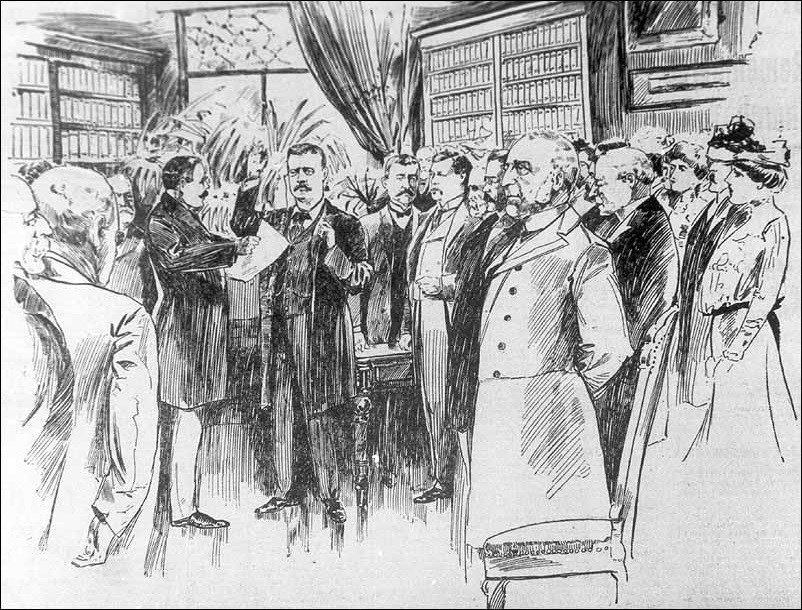
What appears to be taking place in this drawing?
Do you recognize the man raising his arm?
Setting the Stage
As a New York State Assemblyman in the 1880s, Theodore Roosevelt (1858-1919) fought to reform the political and social system that kept many people out of work or in poverty. As Governor of New York (1898-1900), Roosevelt continued to reform state politics and pressure businesses to improve pay and conditions for workers. He alienated many members of his own party with his reforms.
At the 1900 Republican National Convention, New York State Republicans nominated Roosevelt for Vice President in an effort to remove him from the Governor's office. Republicans from other states tried to block the nomination because they feared what would happen if Roosevelt became President. Even presidential nominee William McKinley hesitated to have Roosevelt on the ticket at first. Nonetheless, McKinley and Roosevelt won the election and took office in March 1901.
On May 20, 1901, Vice President Roosevelt officially opened the Pan-American Exposition in Buffalo, New York, a large fair that highlighted the technological advances of the day and celebrated the harmony among the nations of North, South, and Central America. While visiting the Expo in September, President William McKinley was shot by an assassin and died eight days later. Summoned to Buffalo from the Adirondack Mountains, Vice President Roosevelt arrived shortly after McKinley's death. Within hours, Roosevelt himself became the President of the United States. He took the oath of office in the home of his long-time friend, Ansley Wilcox.
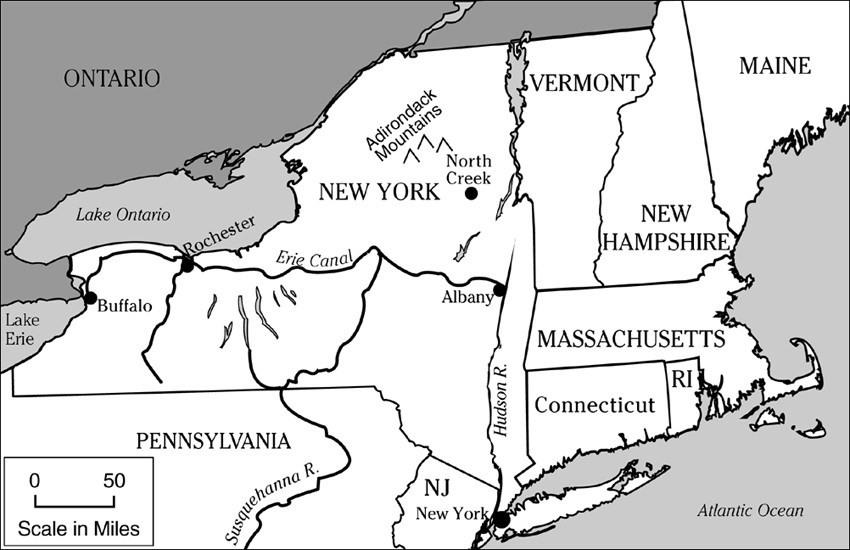
By the mid 1820s, Buffalo, New York, had become a transportation hub as the western terminus of the newly completed Erie Canal. The city eventually earned the title "Queen City of the Lakes." In 1901, Buffalo had the honor of hosting the Pan-American Exposition, a great technological world's fair. Leslie's Weekly wrote, "Few cities in the Western Hemisphere present more remarkable evidences of rapid growth and material progress than does...the Queen City of the Lakes."¹ Buffalo boasted railroads, steamship lines, and an extensive trolley car network. In addition, its close proximity (20 miles) to the waterpower of Niagara Falls gave Buffalo electricity 10 years before most other major cities.
Questions for Map 1
1. Locate Buffalo. What nearby natural features can you identify that may have influenced settlement in the area?
2. Use the map's scale to calculate the approximate length of the Erie Canal.
3. Why do you think Buffalo was a likely place to be chosen to host the Pan-American Exposition, which showcased new technology?
4. Locate the Adirondack Mountains where Roosevelt was vacationing when he learned that McKinley would probably not survive his injuries. What means of transportation would have been available to him to travel to Buffalo? (More information is provided in Reading 1.)
¹Leslie's Weekly Magazine, May 11, 1901.
Determining the Facts
Reading 1: "It is a dreadful thing to come into the Presidency this way..."
President William McKinley arrived at the Pan-American Exposition in Buffalo, New York, on September 5, 1901, and spoke to a large crowd about the need for mutual cooperation among the countries of the Western Hemisphere. The following day, he returned to the Expo for an afternoon reception at the Temple of Music building. A long line of people stood inside the building waiting to shake hands with the President. When a young man with a bandaged right hand approached the President, McKinley offered to shake his left hand. Suddenly the sound of two gunshots rang out. McKinley slumped over, shot twice in the stomach by Leon Czolgosz, an anarchist who had concealed a gun in his bandage. Several men standing nearby wrestled the attacker to the ground while others rushed the President to another room.
McKinley underwent emergency surgery at the Exposition's hospital, which was no more than a first aid station. In the rush to save McKinley's life, the doctors present did not wait for a specialist to arrive before they began surgery. They relied on mirrors to reflect the afternoon sun because only one electric light lit the room. As was the practice at the time, they operated without masks or gloves and did not have the proper surgical instruments with them. The doctors found and removed one bullet but could not locate the second. They refused to use an x-ray machine provided by Thomas Edison because they did not know what long-term effects its use might have on the President. Typical of the time, McKinley was sent to a private home rather than a hospital to recover. He and his wife temporarily moved to the home of John Milburn, President of the Pan-American Exposition.
While delivering a speech in Vermont, Vice President Theodore Roosevelt received word of McKinley's shooting. He arrived in Buffalo the next day, accepting an invitation to stay at the home of Ansley Wilcox, a prominent lawyer. The two had been friends since the early 1880s when they both worked closely with New York State Governor Grover Cleveland. Wilcox recalled that "the family and most of the household were in the country, but he [Roosevelt] was offered a quiet place to sleep and eat, and accepted it."1 The Vice President stayed at the Wilcox house for four days, meeting with newspaper reporters, members of the President's Cabinet, Senators, and other government officials who had gathered in Buffalo after the shooting. Wilcox later wrote, "From the first moment of his [Roosevelt's] arrival, and the favorable answers which were made to his questions about the condition of the President...the Vice President seemed possessed with an abiding faith that the wound would not be fatal.... So, when, on Tuesday...everything seemed to be going well...it was thought best that the Vice President...should go away in order to impress the public with that confidence in the outcome which everyone then felt."2
Roosevelt hurried to the Adirondack Mountains in northern New York State to join his vacationing family. Well-known for his love of the outdoors and the strenuous life, he embarked on a hike up Mt. Marcy, the highest peak in New York State. On his return, Roosevelt saw a man approaching and later recalled, "When I saw the runner I instinctively knew he had bad news--the worst news in the world."3 The messenger handed Roosevelt a telegram explaining that McKinley had developed an infection and was not expected to live through the night. Roosevelt hurriedly arranged for a horse and carriage to take him on the six-hour journey to the nearest train station, 35 miles away in North Creek. At dawn, as he prepared to board a special train to Albany and then to Buffalo, Roosevelt received the terrible news that President William McKinley had died at 2:15 am.
The country had been without a President for almost 12 hours by the time Roosevelt arrived in Buffalo on the afternoon of Saturday, September 14. Many people became anxious for his inauguration to take place. After stopping to pay his respects to the President's widow, Roosevelt returned to the Wilcox home. He requested that the inauguration be quiet and private. The Buffalo Courier reported the next day that "it was hurriedly agreed between the Vice President and members of the Cabinet that it would probably be better to have the ceremonies take place away from the (Milburn) house in which lay the remains of the dead President. The Wilcox house was at once agreed upon."4
Those invited to attend included the Wilcoxes, the Cabinet, U.S. government officials in Buffalo at that time, the doctors who had operated on McKinley, and officials of the Exposition. A few newspaper reporters received permission to attend at the last minute to take notes. Fearing the inauguration might take on a "circus" atmosphere, Roosevelt forbade any photographs taken of the event. The ceremony, in which Federal District Judge John R. Hazel administered the presidential oath, was brief, private, and solemn. The crowd outside milled around for hours hoping to get a glimpse of the new President. Beyond a brief press statement, Roosevelt stayed out of the spotlight for the two days he remained in Buffalo. Later his friend Ansley Wilcox, whose home had witnessed the historical event, wrote, "It takes less in the way of ceremony to make a president in this country, than it does to make a King in England or any monarchy, but the significance of the event is no less great." 5
Questions for Reading 1
1. Why do you think that the crowd, the police guards, and even President McKinley failed to realize that the man with the bandaged hand might be dangerous? Could something like this take place today? Why or why not?
2. What factors caused the doctors to operate on President McKinley under such poor conditions? What might they have done differently?
3. Why did Roosevelt leave Buffalo four days after the shooting? Do you think this action had a positive effect on the public? Why or why not?
4. Why do you think people became anxious to have Roosevelt take the presidential oath? Why did he take the oath in a private home rather than a public building?
5. What do you think Ansley Wilcox meant by his statement comparing the coronation of a king and the inauguration of a president? Explain your answer.
Reading 1 was adapted from sources housed at the Buffalo and Erie County Historical Society and the Theodore Roosevelt Inaugural National Historic Site.
1Ansley Wilcox, "Theodore Roosevelt, President" (unpublished manuscript, 1901; reprinted October 1919, Buffalo and Erie County Historical Society Library Collection, Buffalo, New York).
2Ibid.
3Eloise Cronin Murphy, Theodore Roosevelt's Night Ride to the Presidency (Blue Mountain Lake, New York: The Adirondack Museum, 1977), 19.
4Buffalo Courier, September 15, 1901.
5Ansley Wilcox, "Theodore Roosevelt, President" (unpublished manuscript, 1901; reprinted October 1919, Buffalo and Erie County Historical Society Library Collection, Buffalo, New York).
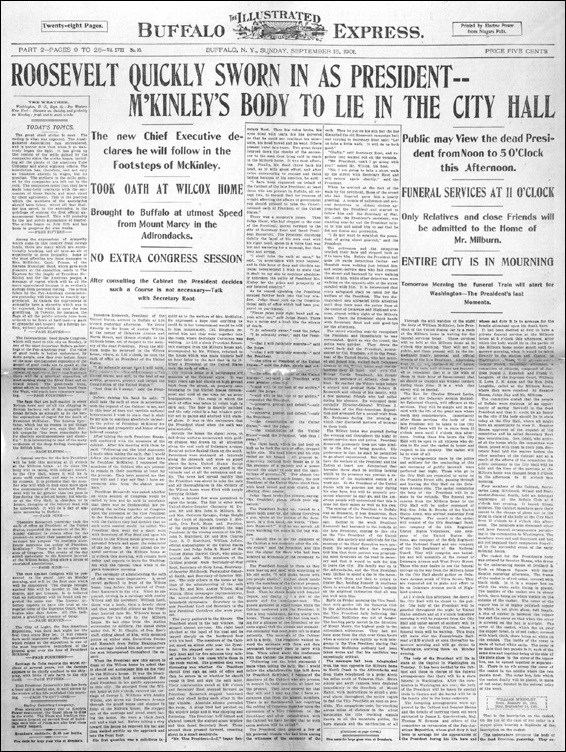
Questions for Document 1
1. What details or facts did the paper choose to emphasize in the headlines and bylines? Why do you think this was so? What general tone is conveyed?
2. Circle the following information: date, price, and number of pages. Now look at a newspaper from your community and circle the same items. How are the two papers similar? How are they different?
3. When a major event happens today, what is usually our first source of news? What would have been the first source for news at the turn of the century?
Determining the Facts
Reading 2: Roosevelt's First Presidential Proclamation
When Theodore Roosevelt took the oath of office in the library of Ansley Wilcox's home on September 14, 1901, most Americans remained in a state of shock and grief over the death of their beloved President. Some wondered and even worried about what type of president Roosevelt would make. Roosevelt took several steps to calm the fears of the nation and give comfort to mourners. Shortly before the inauguration he made a statement to those gathered in the library that the newspapers printed the following day.
I shall take the oath at once in accord with the request of you members of the Cabinet, and in this hour of our deep and terrible national bereavement I wish to state that it shall be my aim to continue absolutely unbroken the policy of President McKinley for the peace, the prosperity and the honor of our beloved country.¹
After the ceremony, the new President, Cabinet members, and several other advisors met in Ansley Wilcox's study to draft Roosevelt's first presidential proclamation. Filled with crossed out sentences and added words, the first draft clearly shows Roosevelt's apprehension. After rewriting the draft, he threw the original away and issued a typed copy to the press. Wilcox, understanding the importance of the events taking place in his home, removed the papers from the wastebasket and placed them in his scrapbook. Following is Theodore Roosevelt's first presidential proclamation:
By the President of the United States of America:
A proclamation: First part. A terrible bereavement has befallen our people. The President of the United States has been struck down--a crime committed not only against the chief magistrate, but against every law-abiding and liberty-loving citizen.
President McKinley crowned a life of largest love for his fellow men, of most earnest endeavor for their welfare, by a death of Christian fortitude; and both the way in which he lived his life and the way in which in the supreme hour of trial he met his death WILL REMAIN FOREVER A PRECIOUS HERITAGE of our people.
It is meet that we as a nation express our abiding love and reverence for his life, our deep sorrow over his untimely death.
Now, therefore, I, Theodore Roosevelt, President of the United States, do appoint Thursday, September 19, the day in which the body of the dead President will be laid in its last earthly resting place, as a day of mourning and prayer throughout the United States. I earnestly recommend all the people to assemble on that day in their respective places of divine worship there to bow down in submission to the will of Almighty God, and to payout of full hearts their homage of love and reverence to the great and good President whose death has smitten the nation with bitter grief. In witness whereof I have hereunto set my hand and caused the seal of the United States to be affixed.²
Questions for Reading 2
1. Why might some people have been worried or even upset about Roosevelt becoming President? (Refer to your textbooks for information on Theodore Roosevelt's progressive policies if necessary.)
2. Why do you think Roosevelt stated that he planned to "continue absolutely unbroken the policy of President McKinley"? Do you think this was a reasonable claim? Why or why not?
3. Why did Wilcox keep Roosevelt's initial draft of the proclamation? How does it add to our understanding of the people, the place, and the event involved?
4. Are there words in the proclamation that are unfamiliar to you? If so, circle them and try to find out what they mean.
Reading 2 was compiled from documents housed at the Theodore Roosevelt Inaugural National Historic Site.
¹Buffalo Courier, September 15, 1901.
²Buffalo (NY) Express, September 15, 1901.
Determining the Facts
Reading 3: The Bully Pulpit
When Roosevelt began his presidency in September 1901, he faced an administration he did not choose and policies with which he did not necessarily agree. He asked McKinley's Cabinet to remain in office under his administration, but within a year several of it members had resigned. Despite changes in the Cabinet, Roosevelt did not demonstrate how different his policies would be from those of his predecessor until the following year when a national crisis arose over a coal strike.
At the turn of the century, coal was America's principal source of heat and energy. Mining was dirty, dangerous, and unhealthy work characterized by low pay and long hours. Early in 1902 the United Mine Workers went on strike to try to obtain better pay, shorter hours, and recognition of their union. The strike wore on for several months, leaving families without coal to heat their homes and cook their meals. Mine owners asked President Roosevelt to send in the Army to break up the strike as the government had done in the past. Roosevelt did threaten to send in the Army--not to break up the strike, but to work the mines--if the mine owners did not agree to talk to the workers about their demands. For the first time in U.S. history a President took the side of the workers in a labor dispute. Both sides compromised and the strike finally ended peacefully. This action conveyed the message to both the owners and workers of industry that Roosevelt would not be a "status quo" President.
Roosevelt also preached the message that all Americans, regardless of race, ethnicity or religion, had the right to an education and to gainful employment. Roosevelt, who had suffered health problems as a child, felt a special bond with children. As the father of six, he knew the importance of providing a healthy childhood and a good education. He was frustrated that he could not change the child labor laws himself. However, his outspoken and public stand on many issues helped initiate later efforts to change the laws concerning women's rights, African Americans' civil rights, and child labor. Unfortunately, Roosevelt did not live to see most of the changes he rallied for enacted into law.
Roosevelt not only challenged U.S. domestic policy, but also worked toward expanding the role of the United States in foreign affairs. Since his resignation as Assistant Secretary of the Navy in 1898 to fight in the Spanish-American War, Roosevelt desired to be at the forefront of world affairs. The presidency offered him the opportunity to see the United States become a world power. One world problem that interested Roosevelt was that naval and commercial ships had to travel around South America or Africa to get from one ocean to the other.
Attempts had been made to build a canal through Central America, but nothing had been completed by the turn-of-the-20th-century. In 1903, Columbia offered to negotiate a treaty with the U.S. to build a canal through Panama (then part of Columbia). The Panamanians, who wanted independence from Columbia, offered to make their own treaty with the U.S. to build a canal for less cost. Roosevelt decided to negotiate with the Panamanians. Construction of the Panama Canal began in 1904, and it opened a decade later in 1914.
When Roosevelt won the 1904 presidential election he was "now president...in his own right."¹ He continued to be involved in the affairs of other nations during his second term. In 1905, he helped settle a war between Japan and Russia when he invited representatives from both nations to the United States to discuss the possibility of peace. As a result of the meeting, both sides gave in to some of the demands of the other, and they agreed to end the war. In 1906, Theodore Roosevelt became the first American to win the Nobel Peace Prize. Although Roosevelt chose not to run for President in 1908, he admitted to friends that he probably enjoyed being President more than any other man. The position had allowed him to publicly say and do things he thought important for the nation and the world. His time in office truly offered him a "Bully Pulpit." He did run for President again in 1912 as a candidate for the Progressive or "Bull Moose" party but lost to Democrat Woodrow Wilson. Roosevelt died in 1919 at the age of 60.
Questions for Reading 3
1. What is meant by the phrase "status quo"? List some examples of how Roosevelt challenged the status quo.
2. Why do you think the Panama Canal was important to Theodore Roosevelt? Would you have negotiated with the Colombians or the Panamanians? Explain your answer.
3. Theodore Roosevelt called the Presidency a "Bully Pulpit." What did he mean by that? Find examples in the reading to support this phrase.
Reading 3 was adapted from Lewis Gould, The Presidency of Theodore Roosevelt (Lawrence, Kansas: University Press of Kansas, 1991); and other sources housed at the Theodore Roosevelt Inaugural National Historic Site.
¹Lewis Gould, The Presidency of Theodore Roosevelt (Lawrence, Kansas: University Press of Kansas, 1991), 146.
Visual Evidence
Drawing 1: Delaware Avenue, Buffalo, New York, 1873.
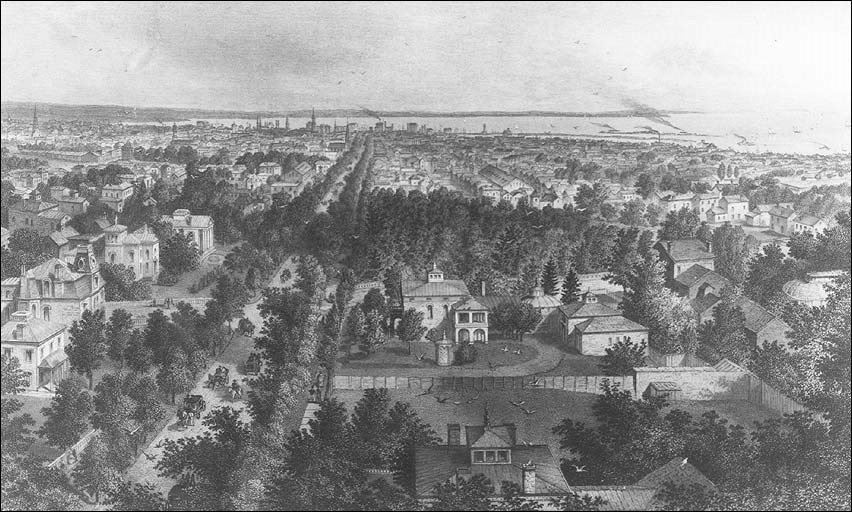
The house where Roosevelt became our 26th President, known today as Theodore Roosevelt Inaugural National Historic Site, was constructed in 1839 as part of a United States Army Barracks at the northern boundary of Buffalo. Strained relations between the United States and Great Britain during this period and political unrest in Canada during the Upper Canada Rebellion caused alarmed citizens to petition the government to build a military post in Buffalo. The commanding officer and post surgeon occupied the house, which was described as "a substantial building, with a portico and large columns."¹ When the Army abandoned the barracks in the 1840s, the house passed into private ownership. In 1884, Buffalo lawyer Ansley Wilcox and his family took up residence there. By that time Delaware Avenue had become the most fashionable street in the city. Elegant mansions lined both sides of the avenue while stately elm trees formed a canopy over it.
Questions for Drawing 1
1. Why did Buffalo citizens want to have a military post in the area?
2. What happened to the house after the Army left the area?
3. Based on the short quote above, try to locate the Theodore Roosevelt Inaugural National Historic Site on the left side of Delaware Avenue. What features may have made this a popular area for wealthy families to live?
4. What evidence can you find in the drawing of Buffalo's growth as an industrial city?
Visual Evidence
Drawing 2: Sketch of the inauguration,
September 14, 1901.

(National Park Service)
The drawing appeared in the Nashville, Tennessee News on October 13, 1901.
Questions Drawing 2
1. Why must we rely on an artist's drawing for details of the inauguration ceremony rather than photographs? (You may need to refer to Reading 1). Do you think this drawing could be an accurate representation of the actual event? Why or why not?
2. Describe the scene in the drawing. How does it compare to the description presented in Reading 1?
3. How does this inauguration ceremony compare to those you have seen on television, in videos, or in photographs?
Visual Evidence
Photo 1: The Wilcox library today.
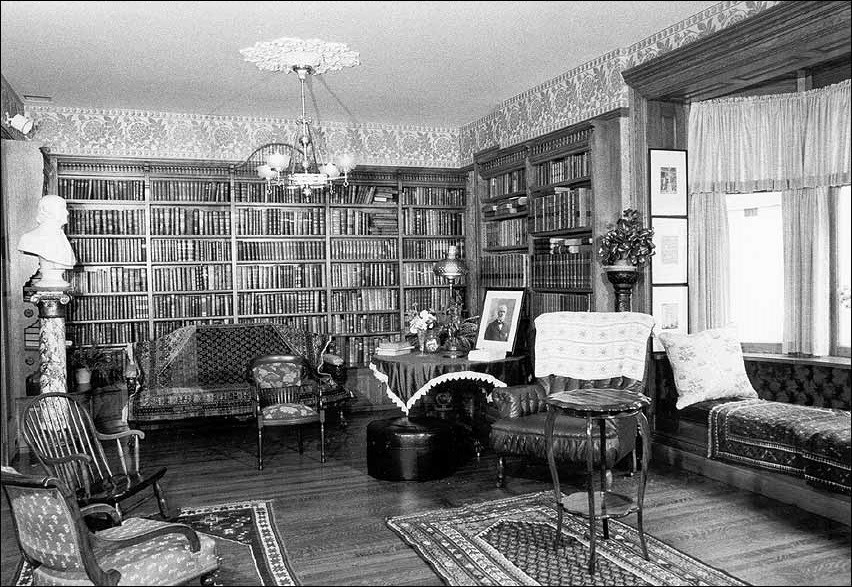
The Wilcoxes improved upon the interior and exterior of their house, transforming it into a stately mansion reflecting the status of a prominent lawyer and his wealthy wife. They turned the two first-floor parlors into the large library pictured here. The room has been meticulously restored to its 1901 appearance.
Questions for Photo 1
1. What can this photo tell you about the Wilcox family and their lifestyle? What can it tell you about life in general at the turn-of-the-century?
2. Why might this room have been chosen for the inauguration?
Visual Evidence
Photo 2: The Wilcox House, September 14, 1901.
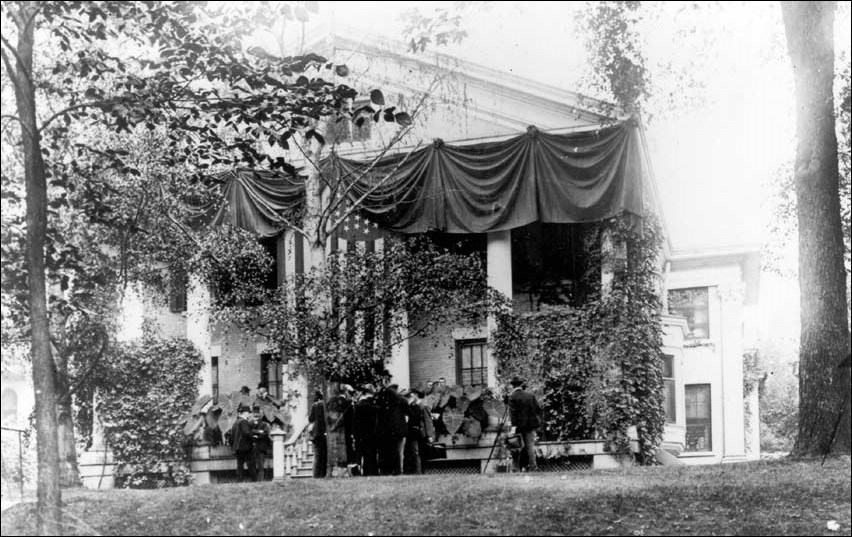
Questions for Photo 2
1. Why is there a flag and black bunting hanging from the house? Who do you think put them up and when?
2. Why are men standing in front of the house? What clues indicate the profession of at least one of the men?
3. How do you think the people standing outside of the house at the time of the inauguration felt? How do you think you would have felt?
Visual Evidence
Photo 3: The Wilcox House, September 1971.
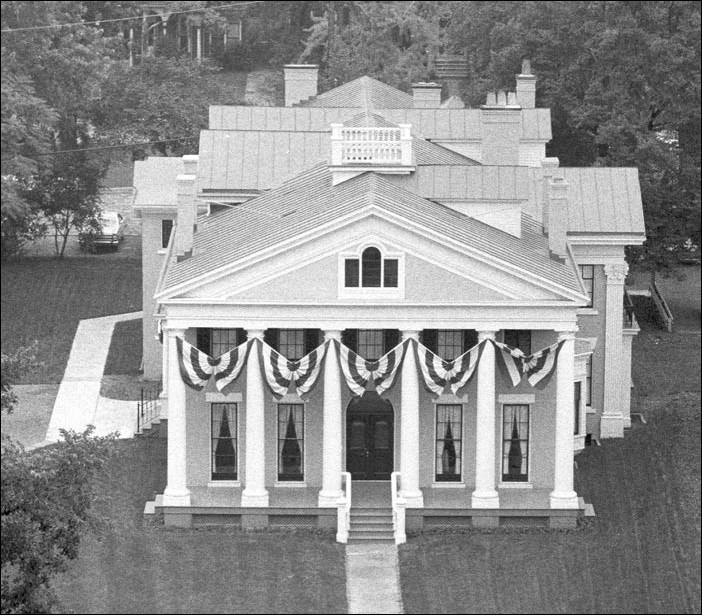
The Wilcox family lived in this house until the early 1930s. After a failed attempt to raise funds to turn the house into a memorial, it became a restaurant. During the 1960s, the house was spared demolition when the Liberty Bank offered to purchase it in return for permission to build a branch office on what had been the Wilcoxes' garden. In 1970, the restored building became a national historic site. The sited opened to the public on September 14, 1971, 70 years after Roosevelt's inauguration.
Questions for Photo 3
1. Compare Photos 2 and 3. What are some of the differences in the appearance of the house and yard between the 1901 and 1971 images? What might account for these changes?
2. Do you think the Liberty Bank's proposal resulted in a fair compromise? Why or why not?
Putting It All Together
The following activities will help students understand the impact of national events on the American public and how such events relate to the history of their own community.
Activity 1: Where Were You On the Day...?
President McKinley's shooting was a shocking event for Americans in 1901. By interviewing parents, grandparents, great-grandparents, or friends, students can learn the personal feelings of people who remember more recent tragedies. Ask the students to find one person who remembers what he or she was doing on the day each of these events occurred: (1) the attack on Pearl Harbor in 1941, (2) the assassination of President John F. Kennedy in 1963, (3) the assassination of Dr. Martin Luther King, Jr. in 1968, (4) the explosion of the space shuttle Challenger in 1986, and (5) any major event that occurred in their community that is still remembered today. Have students compile notes from their interviews and ask them to share what they have learned.
Activity 2: A Snapshot of History
Ansley Wilcox kept a scrapbook of the events that took place in his home, in Buffalo, and in the United States between May and November of 1901. For one month have each student follow an ongoing national event such as a presidential election, a trial, or a sports team's effort at winning a championship by clipping an article out of the newspaper every day. Each day also have them clip an article on an interesting local story even if it is not ongoing. Students should paste the articles in a notebook and write one or two sentences telling what happened in their lives that day. If they have a "souvenir" (ticket stub, photo, etc. ) from that day, have them include it with their notes. At the end of the month, hold a classroom discussion on the brief "snapshot" students have created of their nation, their community, and their family.
Activity 3: Buildings That Have Witnessed History
Ask students to locate a home or building in their community that has served many different purposes over the years. Using primary resources such as atlases, directories, property tax records, census data, and photographs, have the students trace the history of the structure from its construction to the present day. They may want to interview people who lived near the structure for a long time. Then ask students to make a time line with information about the structure at various times in its history on one side. On the other side have the student write what happened in the United States during that same time period. The students may want to donate the completed project to the local historical society so that others can benefit from their research.
Theodore Roosevelt Inaugural Site: Birthplace of the Modern Presidency--
Supplementary Resources
By looking at The Theodore Roosevelt Inaugural Site: Birthplace of the Modern Presidency, students examine the circumstances under which Theodore Roosevelt first became President of the United States and how his policies and actions modernized the presidency. Those interested in learning more will find that the Internet offers a variety of interesting materials.
Theodore Roosevelt Inaugural National Historic Site
The Theodore Roosevelt Inaugural National Historic Site is a unit of the National Park Service. Visit the park's web pages for information on Ansley Wilcox as well as exhibits on the 1901 events that made this house nationally significant.
Theodore Roosevelt Birthplace National Historic Site
Theodore Roosevelt Birthplace National Historic Site is a unit of the National Park Service. Located in Manhattan, New York, this site preserves his childhood home that he occupied from his birth on October 27, 1858 until he reached 14 years of age. Visit the park's web pages for more information about this site.
Sagamore Hill National Historic Site
Sagamore Hill National Historic Site is a unit of the National Park Service. Visit the park's web pages for more information on this residence of President Roosevelt from 1886 until his death in 1919. The home was also the site of presidential activity as it was the "Summer White House" throughout both of his terms.
Theodore Roosevelt Association
The Theodore Roosevelt Association organization has a wide range of sources and publications relating to the life and works of Theodore Roosevelt. The website includes everything from quotations, to reviews on biographies, to his family tree. Some kid-friendly links include "Theodore Roosevelt and the Teddy Bear" and "Teddy & The Children's Room," both featuring answers to children's questions about the life of our 26th President.
American Presidents, Life Portraits
In this series, C-SPAN explores the life stories of the men who have been president by traveling to presidential homes, museums, libraries, and grave sites and speaking with presidential scholars. Included is on the website is information about the American President, Theodore Roosevelt.
The Smithsonian
The Smithsonian has an online exhibit entitled "Theodore Roosevelt: Icon of the American Century." This feature breaks down his life into three parts: first his early childhood and early political life, his presidency, and finally his post-Presidency personal and political adventures. Also included is a brief chronology of his major accomplishments and links to biographies of other key contemporary figures.
Library of Congress: American Memory Collection
Search the American Memory Collection Web page for a variety of historical resources on Theodore Roosevelt. Included on the site are documents, photographs, and other materials on the life of this extraordinary man. Also search on Theodore Roosevelt Inaugural National Historic Site for architectural documentation of the site by Historic American Buildings Survey/Historic American Engineering Record.
For Further Reading
Students (or educators) wishing to learn more about Theodore Roosevelt may want to read: A. E. Campbell, America Comes of Age: the Era of Theodore Roosevelt (New York: American Heritage Press, 1971); Hermann Hagedorn, The Boys' Life of Theodore Roosevelt (New York: Harper, 1922); Theodore Roosevelt, A Bully Father: Theodore Roosevelt's Letters to His Children (New York: Random House, 1995).
Tags
- theodore roosevelt
- theodore roosevelt inaugural national historic site
- presidential history
- president teddy roosevelt
- president theodore roosevelt
- william mckinley
- presidential assassination
- new york
- new york history
- national register of historic places
- nrhp listing
- teaching with historic places
- twhp
- american presidents
- gilded age
- u.s. in the world community
- twhplp
